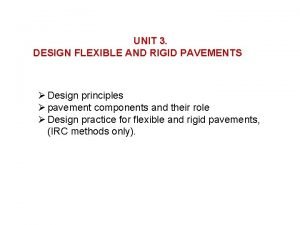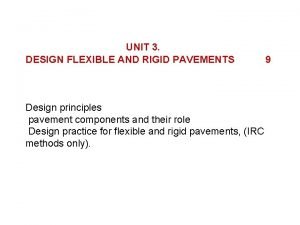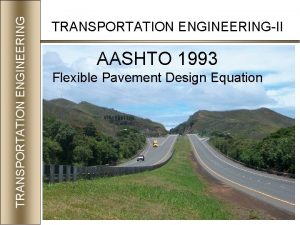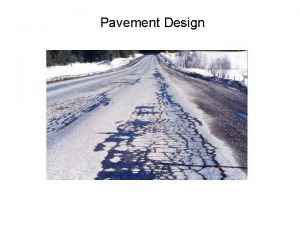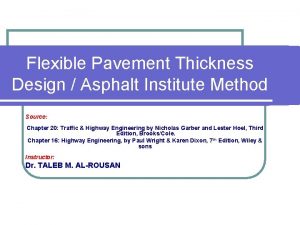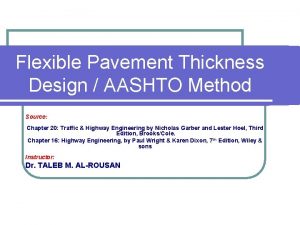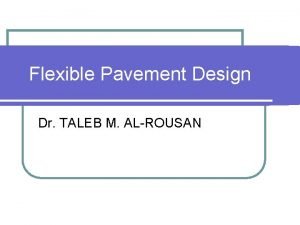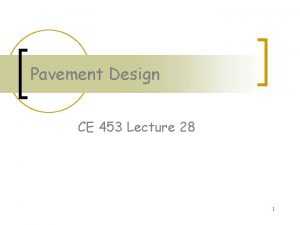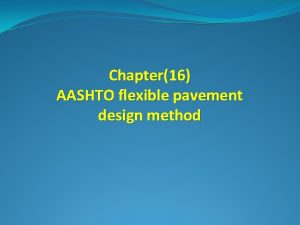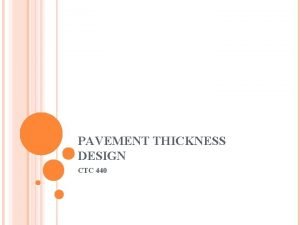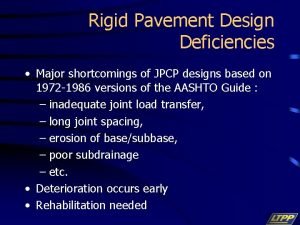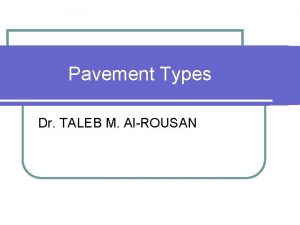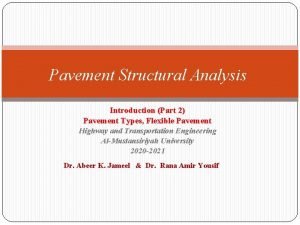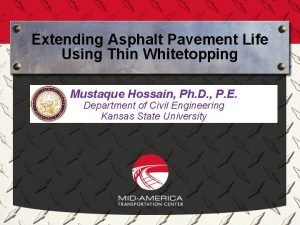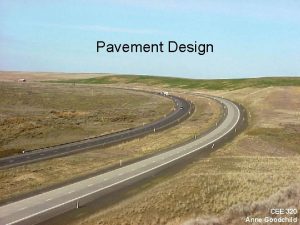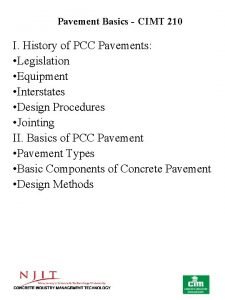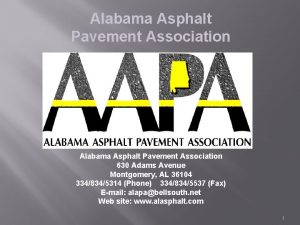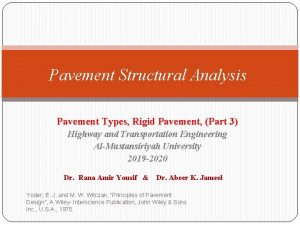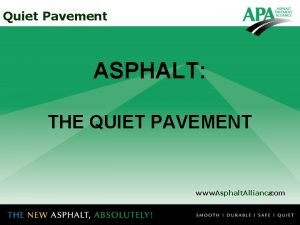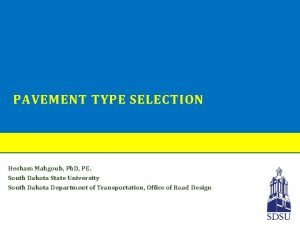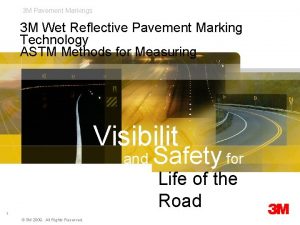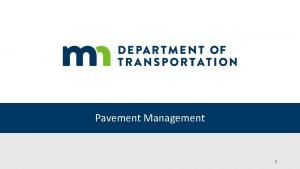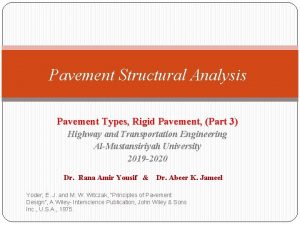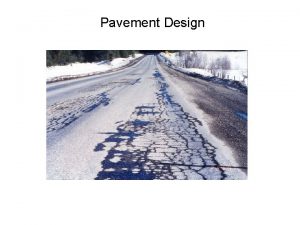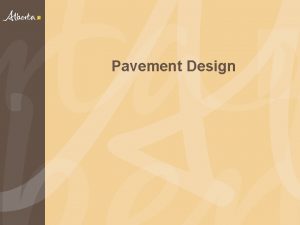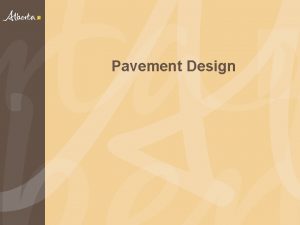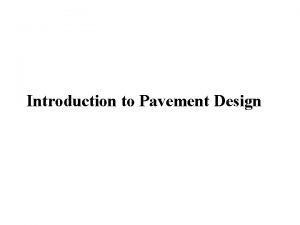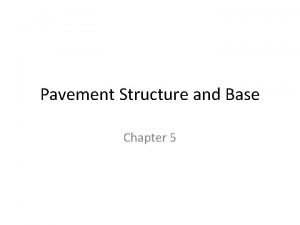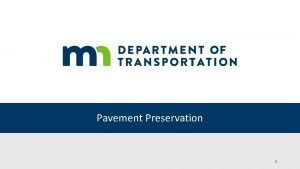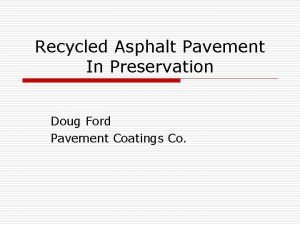Pavement Design Guidance 1 Outline Pavement Design guidance
















































- Slides: 48

Pavement Design Guidance 1

Outline • Pavement Design guidance • Pavement Design resources and links 2

Pavement Design guidance

Pavement Design guidance Pavement Types • Flexible (Hot-Mix Asphalt – HMA) Pavement Design • Standard Design • Low-Volume Design • Rigid (Portland Cement Concrete – PCC) Pavement Design • Aggregate Surface (Gravel) Road Design 4

Standard Pavement Design State Aid Rules State Aid Operations Chapter 8820, sections 8820. 9920 to 8820. 9986, requires all pavements to be designed meeting minimum structural design strengths. • Ten Ton • Staged Ten Ton • Nine Ton • Seven Ton 5

Standard Pavement Design (continued) Ten Ton Pavement Design Rural divided roadways and roadways having projected AADT of 1, 500 or more must be designed to the ten ton standard. Staged Ten Ton Pavement Design Ten ton pavement design is recommended for all new or reconstructed pavements and suburban undivided roadways having a projected AADT of 150 to 1, 499. It is permissible to design a nine ton pavement with intent to increase it to a ten ton capacity at a later date. This is referred to as “Staged Ten Ton Design”. The geometric typical sections of the original nine ton pavement design must be constructed to accommodate the future ten ton design typical section. 6

Standard Pavement Design (continued) Seven and Nine Ton Pavement Design Rules allow for design of seven and nine ton strength roadways. • Minimum nine ton pavement design is permissible within municipal corporate limits. • Minimum seven ton pavement design is permissible for Natural Preservation Routes. 7

Flexible Pavement Design Most roadways in Minnesota are designed as flexible hot mix asphalt (HMA) pavements. There are three standard design methods available for HMA pavements. These are covered in this presentation. • State Aid Flexible Pavement Design Charts using Soil Factor • Flexible Pavement Design, R-value Method • Mn. PAVE Flexible 8

Low-volume Roadway Flexible Pavement Design It is recognized certain low-volume roads designed to minimum standards fail because of environmental factors including oxidation, freeze-thaw action, thermal cracking, etc. A memo was issued by State Aid in February of 2015 to address inquiries from city and county engineers about designing asphalt mixtures for low-volume paved roadways. 9

Rigid Pavement Design Rigid pavements of Portland Cement Concrete (PCC) consist of either new PCC pavements or concrete overlays. There are two types of concrete overlays; PCC pavement placed on existing PCC pavement (concrete overlay) and PCC pavement placed on an asphalt pavement (whitetopping). Concrete overlays can be designed as either bonded or unbonded. Chapter 5 of the Mn. DOT Pavement Design Manual should be consulted for design of PCC pavements. 10

Aggregate Surfaced Road Design Good aggregate surfacing is key to good performance of the driving surface. State Aid has reviewed several aggregate surfacing design guides and recommends using the Gravel Roads Maintenance and Design Manual developed by South Dakota Local Transportation Assistance Program or SD LTAP (November 2000) for design of these roadways. 11

Pavement Design

Pavement Design Types of Pavement Design • Flexible Pavement Design • Standard Design • Low-Volume Roadway Design • Rigid Pavement Design • Aggregate Surface Road Design 13

Pavement Design (continued) Pavement Design When preparing to design a pavement two pieces of information are required: • Estimated traffic loading over the design life of the pavement Traffic loading is calculated from the Average Annual Daily Traffic (AADT) and reported as Equivalent Single Axle Loads (ESAL’s). The State Aid ESAL Calculator can be used to calculate 10 ton ESAL’s. Flexible (HMA) pavements and PCC pavement overlays are typically designed for a 20 year life while rigid (PCC) pavements are designed for a 35 year life. • Soil subgrade strength Soil strength is defined as either Soil Factor (SF) or R-value. 14

Where do I find traffic data? • Go to Mn. DOT website • Under “Topics A to Z” search for “Traffic Counts” Click here! Then click here! “T” for “Traffic Counts” 15

Then click here! “T” for “Traffic Counts” Scroll down to: Click here! Where do I find traffic data? (continued)

Click on appropriate item Where do I find traffic data? (continued)

ESAL Calculator State Aid Equivalent Single Axle Load 10 Ton ESAL Calculator 18

ESAL Calculator (continued) Mn. DOT vehicle type classification scheme 19

Click here! Scroll down and Click here! State Aid 10 Ton ESAL Traffic Forecast Calculator

State Aid 10 Ton ESAL Traffic Forecast Calculator (continued) ESAL calculator consists of two worksheets: 1. Default Traffic Values 2. User Defined Traffic Values 21

ESAL Calculator (continued) “Default Traffic Values” page Incorporates heavy commercial traffic percentages in the ESAL calculation from Report 2010 -17. 22

Soil Strength and R-value How is soil strength obtained or determined? Soil Factor • From historic county design records each county has this defined. R-value • Actual through testing a soil sample. • Geotechnical consultant can estimate from field exploration involving soil borings. • Estimate from chart based on known soil type(s) within project limits. 24

Soil Strength and R-value (continued)

Flexible Pavement Design • Standard Design • State Aid Flexible Pavement Design Charts • R-value Method • Mn. PAVE-Flexible • Low-volume Roadway Design • State Aid Low-volume Roadway Design Memo 26

Pavement Design Charts (using Soil Factor) • Ultimate 10 ton Staged Pavement Design • 7 and 9 ton Pavement Design • 7 ton Natural Preservation Routes Pavement Design 27

Pavement Design Charts (using Soil Factor) (continued)

Pavement Design Charts (using Soil Factor) (continued)

Pavement Design Charts (using Soil Factor) (continued)

Flexible Pavement Design (Standard) Flexible Pavement Design R-value Method 31

Flexible Pavement Design (Standard) Mn. PAVE 32

Flexible Pavement Design (Low-volume) Low-volume Roadway Flexible Pavement Design (February 2015 Design Memo) 33

Flexible Pavement Design (Low-volume) (continued) Low-volume Flexible Pavement Design • Should only be considered for roads with <1, 000 AADT and less than average heavy truck traffic. • Use aggregate size “A” (-1/2”, SP 9. 5) for the final lift. • RAP is recommended to be used in the asphalt mixture. • Use traffic level 2 for mix design. • Specify wearing course with 3. 0 percent design air voids. • Recommended asphalt binders: • PG 58 -28 (“B Oil”) for asphalt pavement overlays. • PG 58 -34 (“C Oil”) for new asphalt pavements. 34

Flexible Pavement Mix Design Criteria Asphalt Mix Design Criteria • Mn. DOT Specification 2360 • Guidance is available: • Mn. DOT Bituminous Engineering under Design • Design Criteria • Binder Guidelines 35

Rigid Pavement Design ACPA Street. Pave • This PCC pavement design software was developed by the American Concrete Paving Association for design of rigid pavements. • Technical Memorandum-SA-03 Authorizes the use of this design software for local agencies in Minnesota. 36

Rigid Pavement Design (continued) Mn. PAVE-Rigid This PCC pavement design software was developed by Mn. DOT for design of rigid pavements. 37

Rigid Pavement Design (continued) BCOA-Bonded Concrete Over Asphalt (BCOA) – ME Design Guide This document guides the user through the design of a bonded concrete overlay placed on top of an existing asphalt pavement. 38

Rigid Pavement Design (continued) Unbonded Overlay Design This is an Excel worksheet developed by Mn. DOT 39

Aggregate Surface Road Design Appendix A: Gravel Road Thickness Design Methods • Gravel Road Design Manual 40

Aggregate Surface Road Design (continued) Mn. DOT Standard Specifications for Standard Construction • 3138 AGGREGATE FOR SURFACE AND BASE COURSES • 3138. 2 -D Surfacing Aggregates Class 1 or Class 2 41

Aggregate Surface Road Design (continued) Mn. DOT Standard Specifications for Construction 3138. 2 D Surfacing Aggregates Surfacing aggregate shall have: • Clay content = 3 percent minimum • Plasticity Index = 5 – 12 OR • Bitumen content ≥ 1 percent OR • Material is composed of at least 25 percent recycled material 42

Pavement Design resources and links

Contacts Mn. DOT and State Aid Pavement Contacts • Joel Ulring, State Aid Pavement Engineer, 651 -366 -3831 • Tim Andersen, Mn. DOT Pavement Design Engineer, 651 -366 -5455 • John Garrity, Mn. DOT Bituminous Engineer, 651 -366 -5577 • Maria Masten, Mn. DOT Concrete Engineer, 651 -366 -5572 44

Resources and links Mn. DOT and State Aid Resources • State Aid Rules Chapter 8820 • Mn. DOT PG Binder Guidelines-MSCR • 2360 Mix Designation Number Examples • Mn. DOT Technical Memorandums 45

Resources and links (continued) Specifications and Special Provisions: Manuals: • 2301 Concrete Pavement • State Aid • 2360 Plant Mixed Asphalt Pavement • Mn. DOT Pavement Design • Special Provisions – SP 2016 • Mn. DOT Grading and Base • Mn. DOT Geotechnical • Mn. DOT Concrete • All manuals 46

Resources and links (continued) Mn. DOT and State Aid Links • State Aid Pavement • Mn. DOT Bituminous • Mn. DOT Concrete • Mn. DOT Pavement Design • Mn. DOT Grading & Base 47

Resources and links (continued) Research: Other partner links: • Local Road Research Board • Concrete Pavement Association of Minnesota • Mn. DOT Research Services • Minnesota Asphalt Pavement Association • Mn. LTAP • American Concrete Pavement Association • Mn. Road • Asphalt Recycling & Reclaiming Association • National Center for Asphalt Technology • Pavement Interactive • FHWA Pavements 48

Questions? Joel Ulring joel. ulring@state. mn. us 651 -366 -3831 49
 Flexible pavement
Flexible pavement Standard axle load for pavement design
Standard axle load for pavement design Difference between flexible and rigid pavement
Difference between flexible and rigid pavement Incisal guidance in complete denture
Incisal guidance in complete denture Indirect guidance examples
Indirect guidance examples The quote sandwich example
The quote sandwich example Aashto 1993 flexible pavement design example
Aashto 1993 flexible pavement design example Asphalt pavement design example
Asphalt pavement design example Asphalt pavement design example
Asphalt pavement design example Asphalt institute
Asphalt institute Aashto 1993 flexible pavement design example
Aashto 1993 flexible pavement design example Standard axle load for pavement design
Standard axle load for pavement design Faarfield
Faarfield Binder course road
Binder course road Austroads pavement design
Austroads pavement design Objectives of pavement design
Objectives of pavement design Flexible pavement design / aashto method example
Flexible pavement design / aashto method example Objectives of pavement design
Objectives of pavement design Aashto rigid pavement design spreadsheet
Aashto rigid pavement design spreadsheet Faa pavement design software
Faa pavement design software Flexible pavement cross section
Flexible pavement cross section No passing zone sign
No passing zone sign Birmingham city council illegal parking
Birmingham city council illegal parking Jpcp pavement
Jpcp pavement Parts of pavement
Parts of pavement Functional evaluation of pavement
Functional evaluation of pavement Limestone pavement labelled diagram
Limestone pavement labelled diagram White topping concrete pavement
White topping concrete pavement Types of joints in concrete pavement
Types of joints in concrete pavement Garber
Garber 320
320 Before you were mine structure
Before you were mine structure Difference between rigid and flexible pavement
Difference between rigid and flexible pavement Parts of pavement
Parts of pavement Signs signals and pavement markings
Signs signals and pavement markings Alabama asphalt pavement association
Alabama asphalt pavement association Contraction joint in rigid pavement
Contraction joint in rigid pavement Longnitudinal
Longnitudinal Quiet asphalt pavement
Quiet asphalt pavement Cost comparison of flexible and rigid pavement
Cost comparison of flexible and rigid pavement Interlocking cement concrete pavement
Interlocking cement concrete pavement Pavement
Pavement How are clints and grikes formed
How are clints and grikes formed Pavement bondi junction
Pavement bondi junction Semi flexible pavement
Semi flexible pavement Difference between www and internet
Difference between www and internet Types of research
Types of research Design process outline
Design process outline Research design is a blueprint outline and a plan
Research design is a blueprint outline and a plan
